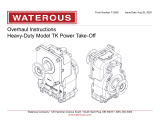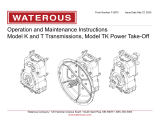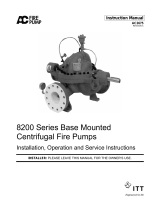
Read through the safety information and
overhaul instructions carefully before repair-
ing your Waterous CPK-5 Series Fire Pump.
Table of Contents
Safety Information ................................................................................... 2
Introduction .............................................................................................. 3
General Description ................................................................................. 3
General Overhaul Information ................................................................ 3
Tools and Equipment .............................................................................. 3
Preliminary Testing ................................................................................. 3
Cleaning ................................................................................................... 3
Pump Bodies and Impellers ....................................................................... 3
Bearings, Gaskets, Seals and O-rings ....................................................... 4
Impeller Shafts ........................................................................................... 4
Installing Ball Bearings .............................................................................. 4
Installing Body Gaskets ............................................................................. 4
Disassembly ........................................................................................ 4 - 5
Reassembly .............................................................................................. 6
Testing ...................................................................................................... 7
Hydrostatic Testing .................................................................................... 7
Operational Testing ................................................................................... 7
NOTE: Instructions subject to change without notice
Waterous Company, 125 Hardman Avenue South, South St. Paul, Minnesota 55075 USA (651) 450-5000
www.waterousco.com
F-1031, Section 5015 (Revised: 9/28/20)
CPK-5 Series Fire Pumps
Overhaul Instructions

Page 2 of 7
F-1031, Section 5015
Safety Information
Please read through the safety information and operating instructions carefully before using your Waterous Fire Pump.
WARNING
Death or serious personal injury might occur if proper operating procedures
are not followed. The pump operator, as well as individuals connecting sup-
ply or discharge hoses to the apparatus must be familiar with these pump
operating instructions as well as other operating instructions and manuals
for the apparatus, water hydraulics and component limitation.
WARNING
Pressure Hazard. May result in personal injury.
Prior to connection or removal of hoses, caps or other closures with pump
intake or pump discharge connections, relieve pressure by opening drains
or bleeder valves. Bleeder valves should also be used while filling a hose
connected to an intake with water.
WARNING
Scalding Water Hazard. May result in serious burns.
When operating the pump, be sure to open at least one discharge valve
slightly to prevent the pump from overheating. If the pump runs for a few
minutes completely closed, it may heat the water enough to scald someone
when the valve is opened. Overheating can damage the seals and other
pump parts. If the apparatus builder has installed a by-pass system or other
provision designed to prevent overheating, opening a discharge valve may
be unnecessary.
WARNING
Unexpected Truck Movement. May result in serious personal injury or
death.
Failure to properly shift transmission in accordance to the transmission op-
erating instructions may result in unexpected truck movement which may
result in serious personal injury or death.

F-1031, Section 5015
Page 3 of 7
Introduction
This section contains overhaul instructions for Waterous CPK-5 Series
centrifugal fire pumps.
Also refer to the Service Parts List (SPL documents), available at
waterousco.com. to aid in further part identification and repair parts order-
ing.
The CP-5 series pumps are designed to provide ultra high pressure and
driven by a K-Series Transmission allowing for pump and roll operation.
Tools and Equipment
The following tools and equipment are needed to overhaul a pump:
1. Usual automotive mechanic’s hand tools.
2. An arbor press for assembling or disassembling components.
3. An engine lathe for turning impeller hubs.
4. A suitable hoist and slings.
5. Torque capability up to 325 lb-ft.
While no special tools and equipment are required, a few special items are
illustrated or described so the mechanic can make them or they are avail-
able from the apparatus manufacturer or the Waterous Company. These
special items are not absolutely necessary, but they will make the me-
chanic’s work much easier.
Preliminary Testing
Before disassembling a pump, test it thoroughly, if possible, and record
the results. A comparison of this test with periodic tests recommended in
form F-1031, Section 1000 can often reveal specific pump troubles. Ex-
cessive speed, for instance, indicates that impellers and/or wear rings are
probably worn.
Cleaning
The continued satisfactory operation of a pump depends to a great extent
upon the cleanliness of its internal parts. Sand, dirt or other abrasive ma-
terial will wear bearings, gears and related parts. Before disassembling a
pump for repairs, be sure to clean its exterior. Make sure the working
space, benches and tools are clean. Use only clean, lint-free cloths to
wipe off components. Before reassembling a pump or its components, be
sure to clean them thoroughly.
Pump Bodies and Impellers
Flush out these components and related parts with clean water. Use a stiff
brush to remove loose scale, caked sediment, etc. Be sure to remove all
traces of old gaskets. Examine pump bodies, covers, adapters and fittings
for cracks, severe corrosion or other damage. Almost all damage to these
parts results from improper use or maintenance, or from freezing. Replace
defective parts.
General Description
General Overhaul Information

F-1031, Section 5015
Page 4 of 7
Bearings, Gaskets, Seals and O-rings
Parts of this nature are frequently damaged during removal or disassem-
bly. In addition, they sometimes deteriorate or lose their effectiveness be-
cause of age or misuse. Replacing these parts whenever overhauling a
pump is a good policy.
Impeller Shafts
Examine shaft for severe scratches, grooves or corrosion - especially un-
der mechanical seals. If scratches are not severe, clean them with a fine-
cut file.
Installing Ball Bearings
Most Waterous pumps are designed so that ball bearings fit tightly on their
shafts and have relatively loose fits in the bearing housings. When mount-
ing these bearings on shafts, always apply force to the inner races. When
bearings have a tight fit in the housings, and a heavy force is necessary to
install them, be sure to apply force only to the outer bearing races. For ei-
ther type of fit, applying force to the wrong bearing race may damage the
balls and race.
Installing Body Gaskets
To provide added sealing for gaskets between body halves, or between
bodies and intake adapters, coat both sides of these gaskets with a suita-
ble sealant. A compound such as Permatex Super 300 is recommended
for this application. Be sure all traces of previous gaskets and sealant are
removed before installing new gaskets.
A CP-5 Series pump may be disassembled by removing the pump and
transmission together, and then disassembling the pump is usually the
easiest method. Refer to service parts list (SPL), available at
waterousco.com, for component identification.
• SPL83421, CP-5 Series Pump Body
• SPL83422, CP-5 Series Pump Impeller Shaft
• SPL83423, Extra Heavy Duty K Transmission
Disassembly

F-1031, Section 5015
Page 5 of 7
► To disassemble the pump, perform the following:
1. Remove two (2) hex head screws (B12) and lock washers (B14)
that attach to the intake adapter (B3)
2. Remove mounting bracket (B5) from the volute body (B1).
3. Remove cooling line (B21) from the intake adapter (B3).
4. Remove ten (10) hex head screws (B11) and lock washers (B14)
that attach the intake adapter to the volute body (B1).
5. Remove intake adapter (B3) using two (2) jacking screw holes.
6. Remove O-rings B6 & B7 and discard.
7. Remove lock nut (S9) and nord lock washer (S10) from first stage
impeller (S1).
8. Remove impeller using puller.
9. Remove square key (S8) from impeller shaft (S3).
10. Remove ten (10) hex head screws (B10) and lockwashers (B14)
that attach the pump head (B2) to the volute body (B1).
11. Remove volute body (B1) from pump head (B2) and transmission.
12. Remove retaining ring (S7).
13. Remove second stage impeller (S2) using puller.
14. Remove mechanical seal silicon carbide ring from the back of the
second stage impeller (S2).
15. Remove and discard O-rings (B6 & B7).
16. Remove four (4) lock nut (T121) and lock washers (T27) from studs
(T121) on transmission (T13).
17. Remove pump head (B2) from transmission (T13).
18. Remove mechanical seal primary ring from the pump head (B2).
Disassembly (con’t)

F-1031, Section 5015
Page 6 of 7
► To reassemble the pump, perform the following:
1. Apply light coating of grease to the O-ring of the mechanical primary
ring (S6) and install it into the groove of the pump head (B2).
2. Protect sealing surface, line up pin with the slot of the primary ring,
and press squarely into bore of pump head until it is seated.
3. Wipe seal surface with denatured alcohol and a clean cloth.
4. Carefully install pump head (B2) onto the transmission.
5. Place square key (S8) into impeller shaft (S3).
6. Apply light coating of grease on ID of second stage impeller (S2)
bore groove, install silicon carbide O-ring.
7. Line up impeller pin (S13) with the groove on the silicon carbide
ring.
8. Press silicon carbide ring onto the second stage impeller (S2).
9. Apply high pressure grease onto second stage impeller (S2).
10. Line up keyway of second stage impeller (S2) into the key (S8) of
the shaft (S3).
.
11. Push the second stage impeller until it seats against the shoulder
of the shaft (S3). An installation tool can be used to prevent break-
age of mechanical seal.
12. Slide retaining ring (S7) until seated into groove.
13. Install volute body (B1) onto pump head (B2).
14. Insert hex head screws into volute body. Torque hex head screws
to 210 lb-ft.
15. Install first stage impeller (S1) using press.
16. Install lock nut (S9) and nord lock washer (S10) onto first stage
impeller (S1). Apply Loctite 542 & torque lock nut (S9) to 75 ft-lb.
17. Install the two (2) O-rings, one (1) on the face and one (1) on the
turn (B6 & B7).
18. Install the ten (10) hex head screws that attach the intake adapter
(B3) to the volute body (B1).
19. Install mounting bracket (B5) onto intake adapter (B3).
20. Install cooling line (B21) onto intake adapter (B3).
Reassembly

F-1031, Section 5015
Page 7 of 7
Before a pump can be returned to service, it is advisable to give the pump
a hydrostatic and operational tests to check it for leaks and to make sure
the pump operates properly.
Hydrostatic Testing
1. Connect the pump to a hydrant or other pressurized water supply.
2. Close all drain lines and open the discharge and priming valves.
3. Open hydrant until the water runs out through the discharge valves
and discharge pipe in priming pump (if used).
4. Close all valves. Be sure to evacuate all air from the pump.
5. Check for leaks with a portable light. If leaks are discovered, tighten
connections or attaching parts as necessary. Repeat until all leaks
are eliminated.
NOTE: If a mechanical seal is used, the seal may leak under hy-
drostatic pressure; however, it should stop leaking after the seal
faces are run in during operational testing.
6. Shut hydrant valve after all leaks are eliminated.
7. Drain pump completely and disconnect intake hose.
Operational Testing
1. Operate the pump at its maximum intended service pressure. Do
not exceed 1350 psi.
2. Check for leaks with a portable light. If leaks are discovered, stop
the pump and tighten connections or tighten attaching parts as nec-
essary. Repeat until all leaks are eliminated.
3. Check for unusual noises, oil leaks, overheated bearings, etc. while
the pump is running. If anything unusual is discovered, stop the
pump immediately and determine the cause of the problem.
NOTE: After reassembling pump, perform vacuum test per NFPA
1911, before the truck is placed back in service.
Vacuum Test
1. Remove all caps except openings without valves. Close all dis-
charge, intake and drain valves and other similar openings. Oper-
ate priming device to create a vacuum of about 22 in. Hg/.735 at-
mosphere in pump, then stop primer and engine.
2. Watch the pressure gauge; if vacuum drops more than 10 in.
Hg/.334 atmospheres in five (5) minutes, listen for air leaks around
O-rings, gaskets, valves, etc.
3. Replace gaskets, O-rings or otherwise repair source of trouble.
4. Repeat test.
Testing
/











